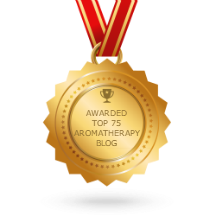 Earlier this week we received an email from a new client. She had placed a rather extravagant 'beginning' order - lots of the "rare and precious" oils. And wrote complimenting us on the quick shipping and excellent packaging..and added "I think I blew out my sense of smell tonight...no one should smell ALL those beautiful scents al at one time. I will be more careful the next time."
Earlier this week we received an email from a new client. She had placed a rather extravagant 'beginning' order - lots of the "rare and precious" oils. And wrote complimenting us on the quick shipping and excellent packaging..and added "I think I blew out my sense of smell tonight...no one should smell ALL those beautiful scents al at one time. I will be more careful the next time."We emailed back and forth all evening...and I realized that she had no clue how to first experience her new oils, and how to "clear her palate" so she wouldn't overload her olfactory nerves.... ie, "blow out her sense of smell."
If you have been working with the oils for a long time, everything here is probably familiar to you, but if not, we hope it helps.
1. How to smell an essential oil:
It's human nature to just open the bottle and inhale, and we all do that sometimes. But that is the worst way to evaluate the richness of the aroma of an essential oil or absolute. Imagine the traditional Brandy Snifter, large and bowl shaped, with just a little brandy at the bottom. The empty space in the glass gives room for the aromatics of the wine to develop and mingle..to dance with each other, for a fuller experience.
When you inhale from the top of the bottle, the aromatic molecules do not have room to expand, to mix, to dance.
At Nature's Gift, while we often will get our FIRST impression of an oil from smelling the top of the bottle, or a bit better, the bottle top (a bit less intense than inhaling directly above the bottle) the only way we will truly evaluate the complexity of an oil is on a scent strip. Yes, we offer "professional" scent strips; we use them ourselves, teachers use them to help their students fully experience the oils.
 |
| Nature's Gift Scent Strips |
You can make your own by cutting construction paper or lightweight cardboard/poster board into strips.
Put one or two drops of the oil on the scent strip or dip the tip of the scent strip into the bottle. Let the oil on the strip dry for a minute or two, then inhale. See what you think of the oil initially. Wait ten minutes and smell the strip again. Twenty minutes, an hour, two hours. Notice how the oil's (or blend's) aroma changes in time. Let it sit overnight and smell it in the morning. The lightest top notes will be barely perceptable the next day; the deep base notes, the woods and roots, will be deeper and richer tomorrow than they are now.
2. How to "refresh your palate":
The above description is all well and good if you have one new oil you want to experience and evaluate. But what if, like my new friend mentioned above, you have a dozen or more. Of course you want to sample them all, right now! But I know that if I am smelling new oils, after about five or six they all start to smell alike. "Olfactory overload" or, as my new friend said "I blew out my sense of smell." There is a fast and simple remedy for "olfactory overload" Keep a small jar of coffee beans. They don't have to be fancy organic French Roased Kenya or Hawaii beans. They can be discount store brand, as long as they are whole beans. Open the jar of coffee beans, smell their aroma for perhaps a minute or two, and you can go back to enjoying your new oils. I have no idea why coffee beans "clear the palate" so you can resume playing with your oils and absolutes, I just know that they do. When we used to travel to trade shows as vendors, we always had a bowl of coffee beans on the sample table. We still use them if a large shipment of new oils come in.
Hope this helps!


2 comments:
Thank you for this very useful information on how the pros experience essential oils.
Glad I saw this - I just did the same darn thing (ie. blew out my sense of smell), lol I forgot all about coffee beans - that totally works! Thanks so much for posting this helpful information!
Post a Comment